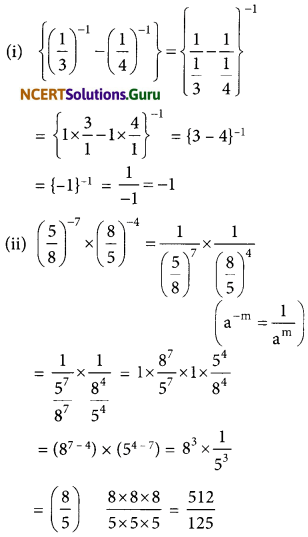NCERT Solutions for Class 8 Maths Chapter 12 Exponents and Powers Ex 12.2
These NCERT Solutions for Class 8 Maths Chapter 12 Exponents and Powers Ex 12.1 Questions and Answers are prepared by our highly skilled subject experts.
NCERT Solutions for Class 8 Maths Chapter 12 Exponents and Powers Exercise 12.2
Question 1.
Express the following numbers in standard form.
(i) 0.0000000000085
(ii) 0.00000000000942
(iii) 6020000000000000
(iv) 0.00000000837
(v) 31860000000
Answer:
(i) 0.0000000000085 = \(\frac{85}{10^{13}}=\frac{8.5 \times 10}{10^{13}}\)
= 8.5 × 10 × 10-13 = 8.5 × 10-12
![]()
(ii) 0.00000000000942 = \(\frac{942}{10^{14}}\)
= \(\frac{9.42 \times 100}{10^{14}}=\frac{9.42 \times 10^{2}}{10^{14}}\)
= 9.42 × 102 × 10-14 = 9.42 × 10-12
(iii) 6020000000000000 = 602 × 1013
= 6.02 × 102 × 1013 = 6.02 × 1015
(iv) 0.00000000837 = \(\frac{837}{10^{11}}=\frac{8.37 \times 10^{2}}{10^{11}}\)
= 8.37 × 102 -11 = 8.37 × 10-9
(v) 31860000000 = 3186 × 107
= 3.186 × 103 × 107
= 3.186 × 103 + 103+7
= 3.186 × 1010
Question 2.
Express the following numbers in usual form.
(i) 3.02 × 10-6
(ii) 4.5 × 104
(iii)3 × 10-8
(iv) 1.0001 × 109
(v) 5.8 × 1012
(vi) 3.61492 × 106
Answer:
(i) 3.02 × 10-6 = 302 x 10-2 × 10-6
= 302 × 10-8 = 0.00000302
(ii) 4.5 × 104 = \(\frac{45}{10}\) × 10000 = 45000
(iii) 3 × 10-5 = \(\frac{3}{10^{8}}\) = 0.00000003
(iv) 1.0001 × 109 = \(\frac{10001 \times 10^{9}}{10^{4}}\)
= 10001 × 109-4 = 10001 × 105
= 1000100000
(v) 5.8 × 1012 = \(\frac{58}{10}\) × 1012 = 58 × 1012-1
= 58 × 1012-1 = 58 × 1011
= 5800000000000
![]()
(vi) 3.61492 x 106 = \(\frac{361492}{10^{5}}\) × 106
= 361492 × 106-5 = 361492 × 10
= 36149200
Question 3.
Express the number appearing in the following statements in standard form.
(i) 1 micron is equal to \(\frac{1}{1000000}\) m.
(ii) Charge of an electron is 0.000,000,000,000,000,000,16 coulomb.
(iii) Size of a bacteria is 0.0000005 m
(iv) Size of a plant cell is 0.00001275 m
(v) Thickness of a thick paper is 0.07 mm
Answer:
(i) \(\frac{1}{1000000}=\frac{1}{10^{6}}\) = 1 × 10-6
1 micron = 1 × 10-6
(ii) 0.000,000,000,000,000,000,16 = \(\frac{16}{10^{20}}\)
= \(\frac{1.6 \times 10}{10^{20}}\) = 1.6 × 101-20 = 1.6 × 10-19
.’. Charge on an electron is 1.6 × 10-19 coulomb.
(iii) 0.0000005 = \(\frac{5}{10^{7}}\) = 5 × 10-7
Size of a bacteria = 5 × 10-7 m
(iv) 0.00001275 = \(\frac{1275}{10^{8}}=\frac{1.275 \times 10^{3}}{10^{8}}\)
= 1.275 × 103-8 = 1.275 × 10-5
Size of a plant cell is 1.275 × 10-5m
(v) 0.07 = \(\frac{7}{10^{2}}\) = 7 × 10-2
.’. Thickness of a thick paper is 7 × 10-2mm
![]()
Question 4.
In a stack, there are 5 books each of thickness 20 mm and 5 paper sheets each of thickness 0.016 mm. What is the total thickness of the stack.
Answer:
Thickness of one book = 20 mm
Thickness of 5 books = 5 × 20 mm = 100 mm
Again, Thickness of one paper sheet = 0.016 mm
.’. Thickness of 5 paper sheets = 5× 0.016 mm
= 0.080 m
Total thickness =100 mm + 0.080 mm = 100.08 mm
\(\frac{10008}{10^{2}}=\frac{1.0008 \times 10^{4}}{10^{2}}\)
= 1.0008 × 102 mm
NCERT Solutions for Class 8 Maths Chapter 12 Exponents and Powers Ex 12.2 Read More »





































